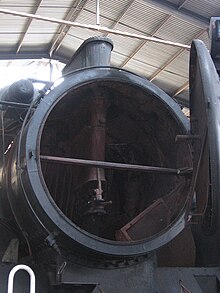Adolph Giesl-Gieslingen
Adolph Giesl-Gieslingen (born September 7, 1903 in Trient , Tyrol ; † February 11, 1992 in Vienna ) was an Austrian locomotive designer and technician .
Life
Adolph Giesl von Gieslingen comes from a family of officers, his father was General Arthur Giesl von Gieslingen , his grandfather the Feldzeugmeister Heinrich Karl Giesl Freiherr von Gieslingen . The general and diplomat Wladimir Giesl von Gieslingen , who as the Austro-Hungarian ambassador in Belgrade handed over Austria's ultimatum to Serbia on July 23, 1914, was his uncle.
Giesl-Gieslingen, as he was called after the end of the monarchy in 1918, studied at the Technical University of Vienna , where he obtained his engineering degree in 1925. In the same year he began his service as a designer in the Floridsdorfer Lokomotivfabrik , where he was involved in building the 214 series , Austria's largest steam locomotive. He constructed a. A. the extra-long connecting rods, with a length of four meters the longest in the world. He obtained his doctorate in 1929. techn. with a dissertation on the improvement of blowpipe systems in steam locomotives. Director Arno Demmer sent him to the USA that same year , where he stayed until 1938. There he met his wife, whom he married in New York in 1933 . After his return he became Demmer's assistant and, after the Second World War, chief designer of the Viennese locomotive factory in Floridsdorf. During the war he was authorized by the German Reich to sell locomotives and the like. A. in Romania, Croatia and Turkey.
In 1946 he took up his position as honorary professor at the Technical University in Vienna as the successor to Johann Rihosek , which he held until 1978. Until 1950 he was with the Austrian embassy in Washington as head of the industrial department of the ERP office.
He developed the Giesl ejector for steam locomotives, which he patented and distributed in cooperation with the Schoeller-Bleckmann-Werke . He had previously tried it out on the Chesapeake & Ohio Railroad in 1949. In his later years Giesl was active as a technical writer, he published several books on the subject of steam locomotive technology for the Viennese publishing house Slezak .
Works
- Locomotive athletes. History, performance and cornering of the six and seven couplers. Slezak publishing house, Vienna 1976, ISBN 3-900134-27-8 .
- The era after Gölsdorf. The last 3 decades of Austrian steam locomotive construction. Slezak publishing house, Vienna 1981, ISBN 3-900134-37-5 .
- Anatomy of the International Steam Locomotive. Slezak publishing house, Vienna 1986, ISBN 3-85416-089-5 .
literature
- Ernst Kabelka: In memoriam Professor Giesl-Gieslingen. In: Rail transport currently. 4/1992, p. 8.
- Ingrid Trummer, Alexander Stollhof (Ed.): “… Here at Lofag…”. Memories of the Floridsdorfer Lokomotivfabrik - Vienna's largest industrial company. Edition Volkshochschule, Vienna 2005, ISBN 3-900799-67-9 .
Web links
- Literature by and about Adolph Giesl-Gieslingen in the catalog of the German National Library
Individual evidence
- ↑ a b c Alfred Horn: Giesl-Gieslingen and his ejector . In: Eisenbahnverkehr Aktuell . No. 1/2016 . Minrex Verlag, Zurich 2016, p. 22 .
- ^ Adolph Giesl-Gieslingen: Anatomy of the steam locomotive . Slezak publishing house, Vienna 1986, ISBN 3-85416-089-5 .
| personal data | |
|---|---|
| SURNAME | Giesl-Gieslingen, Adolph |
| ALTERNATIVE NAMES | Giesl-Gieslingen, Adolf |
| BRIEF DESCRIPTION | Austrian locomotive designer and technician |
| DATE OF BIRTH | September 7, 1903 |
| PLACE OF BIRTH | Trento , then Austria-Hungary |
| DATE OF DEATH | February 11, 1992 |
| Place of death | Vienna |
